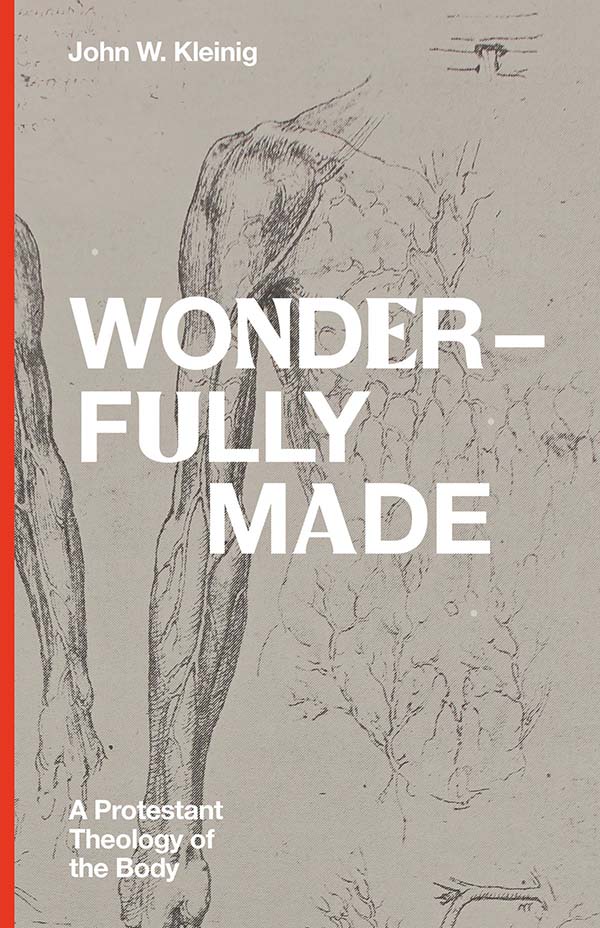Staff Review
Wonderfully Made: A Protestant Theology of the Body
John W. Kleinig
(Lexham)

Wonderfully Made: A Protestant Theology of the Body is an accessible, concise book that offers a positive vision of the Christian body. For readers wanting a straightforward, Scripture-saturated introduction to how to think and act and worship with our bodies, John W. Kleinig’s book will be a helpful read.
Human beings are composed of both soul and body but sometimes in the Christians’ quest for discipleship we prioritize the former over the latter. Indeed, this bifurcation is typically more prevalent among Protestants than Roman Catholics, who can look to Pope John Paul II’s magnum opus The Theology of the Body and, more recently, Catholic theologian Paul J. Griffiths’ Christian Flesh. Yet Protestant thinkers have contributed to the discourse as well, including Ola Sigurdson’s Heavenly Bodies: Incarnation, the Gaze, and Embodiment in Christian Theology and Matthew Lee Anderson’s Earthen Vessels: Why Our Bodies Matter to Our Faith.
John W. Kleinig has joined this conversation with Wonderfully Made: A Protestant Theology of the Body. It is fitting that a Lutheran theologian would write such a book; after all, during the Protestant Reformation(s), Lutherans were more inclined to continue approving of the use of materiality in worship such as crucifixes and sacred images than Reformers influenced by Ulrich Zwingli. Thus, corporality has always had a prominent place in Lutheran theology and life.
I appreciate Kleinig’s posture in this book. Kleinig observes that much evangelical discourse on the body is negative, prohibitory. In the public imagination, Christians are often known better for what we are against rather than what we are for, especially when it comes to what we do with our bodies sexually. Kleinig, instead, wants to describe the positive vision of the Christian body (pp. 16-17). Biblical citations abound in Wonderfully Made, demonstrating its scriptural grounding and it is written in a down-to-earth and pastoral style. Kleinig addresses “the created body,” “the redeemed body,” the “spiritual body,” “the sexual body,” “the spousal body,” and, lastly, “the living body.”
There are many good biblical and pastoral insights in Wonderfully Made. Kleinig explains the importance of how we dress (“Through dress we manage our bodies,” p. 36) and that our clothes cover our shame (shameless people do not care how they dress, pp. 35-36). Through dressing, we cover ourselves but also preserve ourselves for the exclusive eyes of our spouse (pp. 36-37). When Adam and Eve ate of the forbidden fruit and realized they were naked, they sewed fig leaves together but God, in His grace and mercy, prepared “even better clothes for them from the skin of animals” that covered their entire bodies (p. 37). Kleinig addresses modern modest dress in the church on pp. 142-43 and this was an area I wish his pastoral wisdom had gone into greater depth for this is a fraughter topic than his cursory comments suggest, especially for women who tend to be the ones targeted by male modesty mandates. Kleinig (rightly) advises that “we do not dress to advertise our general sexual availability” but there can be a difference of opinion between an old man and a younger woman about what attire is modest and what is not (especially during summer). Kleinig could have elaborated more, perhaps offering some counsel on how to sanctify one’s eyes, one’s sight (for he quite rightly acknowledges that there are instances in art when nudity is fitting and not pornographic, p. 172).
Kleinig counsels us to be particularly considerate and wise when teaching children and youth about their bodies and developing sexuality, especially where there is so much confusion around sex and gender. He advises that children and youth “need to have affectionate, appreciative male and female role models to counter the sexual deceptiveness of popular culture and integrate their identity as a man or a woman with their actual genetic sexual status” (p. 198). Kleinig draws particular biblical inspiration from the Song of Songs as a guide for forming our sexual imaginations; interestingly, he notes that the same language that is used in the Song of Songs for the human body was also used in surrounding pagan cultures to describe idols (pp. 174-75).
Kleinig acknowledges that it can be challenging for people to foster rich friendships in a hypersexualized age. He laments that “The love of a man for another man or a woman for another woman and the love of married women and men for someone other than their spouse is regarded with suspicion as latently or blatantly erotic” (p. 188) and exhorts the church to be the place where friendships, especially for single people, can be promoted and supported in fitting ways (p. 189).
Death is the great enemy of humankind and Jesus’ death is the only good death because through it, Christians have been redeemed (indeed, Christ is able to care for believers in a better way than when he walked this earth for he “now hides himself even more fully as God and man in his word and the holy sacraments, so that we can now have safe access to God the Father through his flesh and blood,” pp, 77-78, 110). Just as Jesus offered his body as a sacrifice for our sake, so too do we offer our bodies as “living sacrifices” to the Father as we strive with the Spirit’s help to be holy (p. 88). Kleinig advises Christians to carefully consider how they plan out funerals and to avoid the therapeutic niceties that the culture has embraced when it comes to marking the passage of death (while also highlighting the Christian hope that proclaims that the dead and the living can cosmically meet as one at the communion table, pp. 140-42). For instance, Kleinig advocates for funerals to take place in church sanctuaries rather than “a secular funeral parlor or at a crematorium” and for funerals to act out the Christian narrative of death and redemption (p. 140). Kleinig dissuades Christians against cremation based on Christian history, even while acknowledging that the Bible does not prohibit such a practice (pp. 140-41).
Several passages are deeply eloquent and moving (as when a pastor reaches the crescendo of her sermon). Kleinig, writing on Jesus and his bride, declares:
“Why does he present her to himself? He does not station her before his face in order to assess her critically, appraise her appearance, and judge whether she is fit to be his bride. He presents her to himself to show his full approval of her, his great delight in her, and his unqualified appreciation of her beauty. Just as he has made her righteous by declaring her righteous, so he makes her beautiful by declaring her beautiful. Like the lover in Song of Songs 4:1, he says to her, ‘Behold, you are beautiful, my love.’ As he parades her before himself, he looks on her with loving admiration. She is perfect in his eyes. He enjoys the sight of her and wants her to enjoy his love. That’s how Jesus regards her and us. He delights in the sight of us. He is happy to see us. He does not just look at us, but he actually sees us; he does not just see us, but he really admires us; he does not just admire us, but he pays close attention to us; he does not just attend to us, but he lavishes his love on us. Like the royal bride in Ps 45:10-13, he, amazingly, desires our beauty, dressed as we are in the royal robes of heavenly glory” (p. 134).
Wonderfully Made is a good primer on the importance of the body for Protestants that is suffused with Scripture but at times Kleinig makes abrupt and contentious claims that I wish were more fleshed out. The book leans complementarian without engaging with egalitarian perspectives. His discussion of divorce is also quite limited, with Kleinig stipulating that adultery is the only reasonable basis for divorce in Jesus’ teachings but that even this is not desired. Again, I agree that divorce ought to always be the last-case resort and it is always painful but what about abandonment of the spousal body or abuse of the spousal body? Kleinig fails to address these reasons and he would have done well to have interacted with biblical scholars who study Scripture’s teachings on divorce such as Craig Keener and David Instone-Brewer. Lastly, in writing about “the privilege of procreation,” Kleinig declares that because God commissioned humans to be “fruitful and multiply (Gen 1:28)...a married couple who can have children but deliberately refuse to do so commits an unnatural, life-denying act of defiance that rejects the blessings God wishes to bestow on them and the whole human race” (p. 52). Granted, there are elements of our culture that, instead of privileging procreation, privilege autonomy (better to be childless and enjoy annual, lavish vacations and live a life of bacchanalian splendor!) that Christians can “counterculturally” witness against through raising families, as Kleinig advises. But I would be hesitant of being accusatory against Christian couples who may choose not to have children for whatever reason.
Protestants stand on Scripture as our highest authority and can rejoice at how often Kleinig appeals to biblical verses to expound the Christian vision of the body. Yet beyond the Bible, Kleinig mostly relies on Luther and Lutheran doctrinal standards such as the Book of Concord and his modern sources are primarily Lutheran biblical commentaries. Kleinig acknowledges that this is the angle from which he approaches this topic (“This book is a pastoral-theological meditation written from a Lutheran perspective,” p. 17) and again, Protestants seeking to recover classical Protestant theology can be grateful to Kleinig for pointing these early Protestant sources out to us but it would be more accurate to subtitle this book A Lutheran Theology of the Body rather than A Protestant Theology of the Body; neither John Calvin, Thomas Cramner, or modern theologians such as those from the charismatic/pentecostal tradition have anything to do with this book. It also doesn’t offer a consideration of how a Protestant/Lutheran theology of the body differs from a Catholic theology of the body. As such, for readers seeking a bit more advanced work on the body, Kleinig’s book will feel underdeveloped, yet its rootedness in biblical truths will give it staying power better than a book that is very dependent upon interacting with sources that may become outdated shortly and that dwell on niche topics.
There are two types of sermons. The first type offers you something new about God’s Word that you never knew before and that can leave a long impression on the listener. The second type is not earth-shattering but quietly affirms fundamental truths. Kleinig’s book is like the latter. Wonderfully Made: A Protestant Theology of the Body is an accessible, concise book that offers a positive vision of the Christian body. For readers wanting a straightforward, Scripture-saturated introduction to how to think and act and worship with our bodies, John W. Kleinig’s book will be a helpful read.



